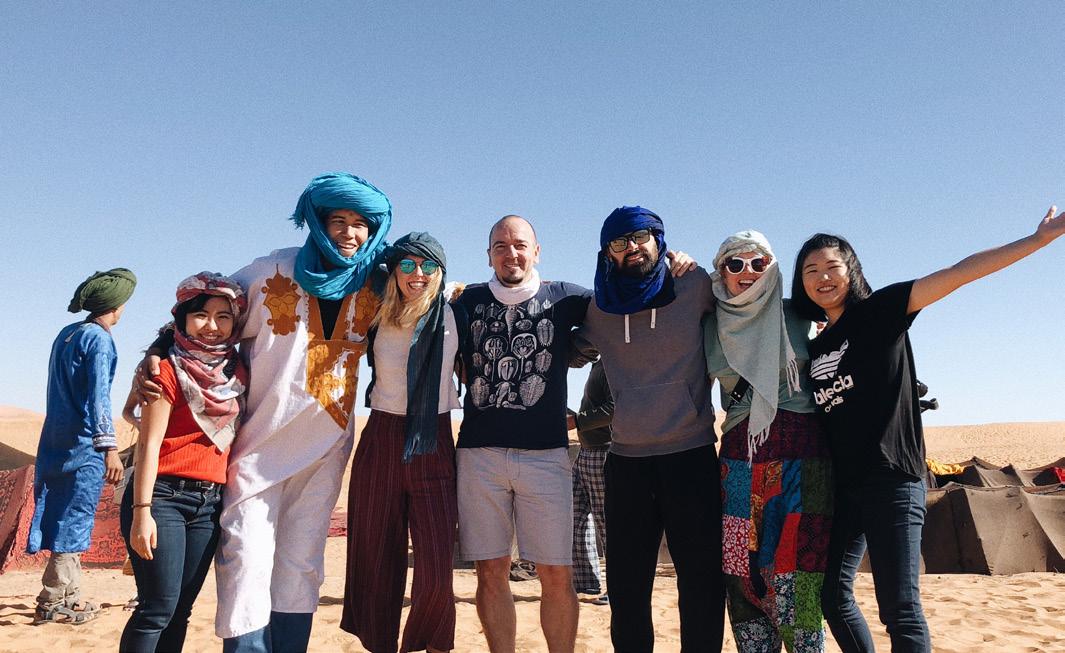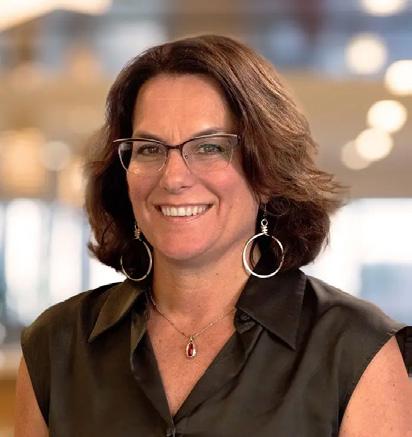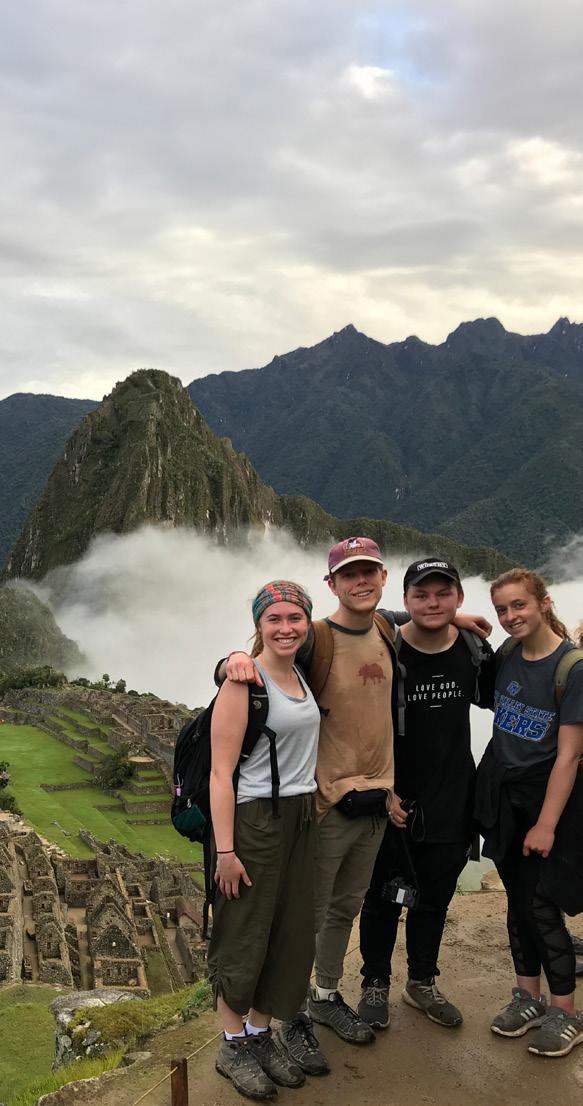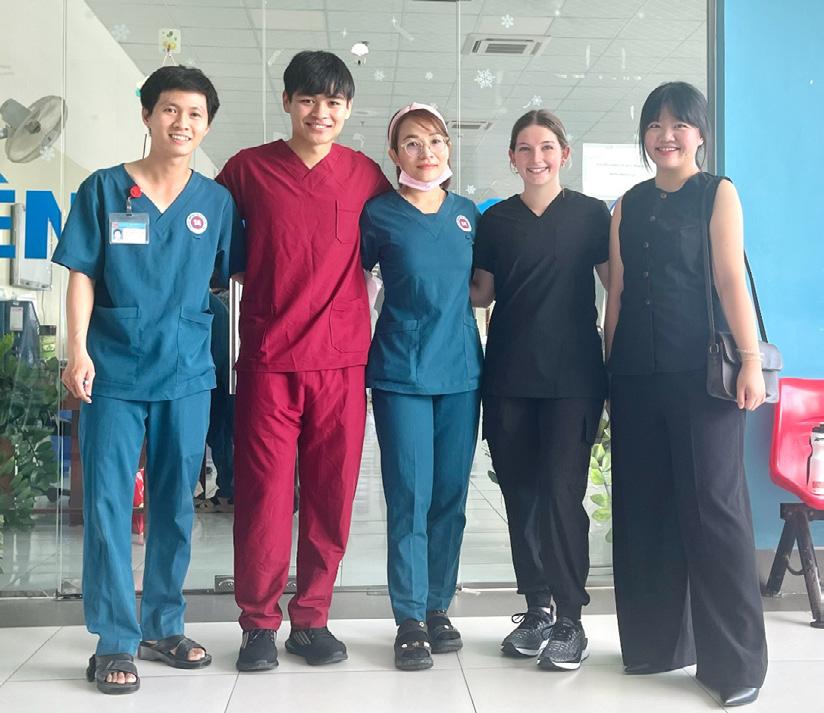2023/2024
Higher education annual report



Introduction

Jennifer Acosta EVP Higher Education
Last academic year demonstrated impressive growth for Higher Education at WorldStrides and for international education at large. This growth reflects our continued dedication to the students and educators who share our passion for educational travel, and we are proud of the role we play in their journey.
In this report, we take a look at the year in review, examining the shifting trends impacting our business and the industry. Throughout this document, we share insights comparing data from the most recent academic year (August 2023 - July 2024) to the prior year. We’ll be looking across our entire portfolio, which includes short-term faculty-led programming, as well as independent or individual experiences such as traditional study abroad, international internships, servicelearning, and research programs.
I am encouraged by this growth, by the positive feedback from participants in our programs, and by the passion I see in our team members every day.
We hope the insights provided within will help guide your office’s initiatives and give you a broader understanding of the programs we have to offer your students in 2025 and beyond. Thank you for your continued support, and we look forward to achieving great things alongside you in the coming year.
Programs for everyone
With a wide variety of education abroad modalities, we offer programs to accommodate the goals of students and universities.
Study Abroad
Our traditional study abroad programs allow students to enroll at one of our partner host universities, where they can experience the life of local students. These programs can range from a twoweek January experience that lets students squeeze study abroad into their winter break to a full academic year. Our programs also allow students to combine coursework with internships, servicelearning, or Veritas Christian Study Abroad at select locations.
Experiential programs
Our experiential programs are designed for students looking to gain career experience, develop research skills, or engage with community-based organizations. Full-time internships, servicelearning, or research programs are available during the semester or summer, with summer being the more popular option for internships and service-learning.
Custom programs
Our faculty-led programs are customized to meet the goals of each university. Our experience in numerous destinations and across academic sectors means that your students and faculty can apply home university curriculum to global contexts.
When it comes to faculty-led programs, we’re determined to partner with you, your faculty, and your budget to deliver an enriching experience that continues to offer a lower barrier to entry for our students looking to study abroad, despite rising travel costs.”
- Jennifer Fisher, Senior Vice President, WorldStrides Higher Education

200+
study and experiential learning programs for individual students
100+
host university partnerships in more than 25 countries


120+
faculty-led destinations with solid partnerships and networks
Taking a Costa Rican healthcare class while doing service-learning at La Clinica Carlos Duran was incredibly valuable and I feel like they were very cohesive: I learned about the public healthcare system in class and then got to see it firsthand in my service learning.”
- Ava Quinlan, Service-Learning Student, Spring 2024
Comparing program trends

Program term
Trends in global mobility are always changing. As students’ interest in destinations, desired travel terms, or academic fields shift, we take note to ensure that our programming aligns with the needs of our participants and their universities.
Traditional study abroad programs are seeing continued growth during semester programs, with 39% of students going abroad during spring semester. We are also seeing growth in short-term programs during J-term, which has increased by almost 11% in the last year.
May is the most popular month to travel for faculty-led programs at 45%. We are seeing about 15% of programs traveling in March, during spring break, and another 15% in June.
65% of study abroad students went abroad during the spring or fall semester.
45% of faculty-led programs went abroad in the month of May.
WorldStrides, especially the local staff in Lima, make all the difference. They provide the assurance that I can confidently focus my attention on the students and course objectives.”
- Michael Bittinger, Assistant Director, Purdue Study Abroad
Program destinations
For study abroad students, Europe continues to be a top location, with Spain, Italy, and France holding the top spots.
When it comes to faculty-led programs, Europe remains the most popular region among faculty, with Spain, Italy, and the United Kingdom making up the top three. Asia, Africa, and Latin America are gaining traction, though – all three regions saw double-digit growth year over year!
Faculty-led programs that visit multiple locations have always been popular, but this year saw a nearly 50% increase in the number of undergraduate programs going to two or more countries.
A closer look at Latin America
After Europe and Asia, Latin America is the third-most popular region for faculty-led programs. We have a long-time relationship with companies throughout the region, providing engaging and relevant experiences for students.
Program spotlight
Global Leadership in Peru with Purdue University
Asia on the rise
South Korea up 47% among study abroad students
Japan up 47% among faculty-led programs
Traditional study abroad in Latin America
To increase future enrollments in Latin America, our team will be focusing on the value of these programs. Our Latin American programs boast:
• Great host universities
• Greater immersive experience (community, culture, language proficiency)
• Smaller programs that approximate the local experience more closely
Designed for incoming first-year students, this program offers hands-on learning experiences, bridging theory and practice within the unique context of Peru’s rich cultural and ecological heritage. These students seek to develop a comprehensive understanding of sustainable development practices, global policy frameworks, and local community engagement, while fostering collaboration with peers from around the globe.
Custom program trends


Our custom programs, also referred to as faculty-led programs, continue to see increased enrollment at the undergraduate level. 62% of our faculty-led programs were developed for undergraduate students.
Note: It was growth in our faculty-led programs that inspired us to develop our First Year Abroad programs, where we hope to convert the success of first-year custom programs into cohort-model semester experiences.
Scholarships for Custom Programs
We’re proud to offer scholarships for traveling students each year. This scholarship program evolved from our belief in the value of creating future global leaders and citizens through transformational study abroad experiences.
Being chosen as a recipient for the Natalie Shea Memorial Scholarship means the absolute world to me. It has not only made my dreams of studying abroad a reality but has also reinforced the significance of education as a gift that transcends all barriers, including financial ones. Inspired by Natalie Shea’s passion for travel, exploration, and diverse cultures, I am eager to represent Arizona State University as I engage with the ancient shrines of Tokyo and beyond.”
- Genesis, Arizona State University, Natalie Shea Memorial Scholarship - Summer 2024 62%
Trends in Participant Engagement
Our Global Experiences team works with industry experts and dynamic organizations to give participants real-world applications and immerse them in relevant, interactive projects.
While company visits and meetings continue to be the most popular academic engagement choice, we recorded increased interest in both service-learning opportunities and strategy challenges over the prior year. This year, students have experienced everything from a moot court capstone on South African constitutional law using real legal scenarios to an inside look into supply chain logistics in Hong Kong.
The supply chain logistics academic engagement gave students real-world understanding of what they were studying in the classroom and the importance of the industry in the region.”
- Xu (Cissy) Hartling, Associate Professor at Salem State University
With the number of business & economics majors continuing to rise, it’s no surprise that this is the top academic area for on-program engagements for faculty-led programs, as well. Engagements with a focus on communications & media more than doubled since last year.
More than 22.5% of our program engagements fall under other niche areas of study, showcasing our ability to create customized engagements on any topic to fit specific program goals.
Student demographics
Understanding who our students are is critical to ensuring program accessibility. As patterns relating to gender, area of study, financial need and more arise, we ask ourselves how we can increase access as well as provide support to first time travelers
Gender
Students who identify as female make up the majority of our travelers, though we have seen a slight increase over the prior year in the participation of students who identify as male. While we are seeing a decrease in the number of students identifying as X on their passport, this is not indicative of the number of housing preference requests we receive.
Clearing roadblocks

12% of our travelers self-report as first-generation college students. As we seek to to make study abroad approachable to a broader range of students, we are guided by the following questions:

What unique challenges might these students face while abroad, and how can we support their journey?

While facing unfamiliar educational environments is challenging, how can we better prepare students?

How can we ensure they make the most of the resources provided by their host universities and WorldStrides?

Year of study
Financial aid
With nearly 50% of students using some form of financial aid to go abroad, we strive to help reduce financial barriers through scholarships, grants, payment plans, and more.
52%
increase since last year in scholarship submissions
43% of our non-direct bill participants are utilizing financial aid to pay for all or part of their program
Last year showed increased enrollment from freshman, sophomores, and juniors – the largest increase among sophomores at 33% – and a decline in enrollment amongst seniors (-15%).
An anomaly in the data
We saw an increase in fourth-year student mobility immediately after the pandemic. These were students who had to wait for programs to reopen before fulfilling their study abroad goals, which created a somewhat anomalous shift, so seeing a decline in fourth-year enrollment now is a natural resetting.

Area of study
Business majors continue to be a growing demographic on our programs, while students majoring in international studies or languages are in decline.
However, students’ course selections while abroad speak to their interest in combining major coursework with courses that align with their host culture/destination. This trend is particularly noticeable in short-term programs, such as J-term, where course selections abroad do not appear to align with student majors.
We’ve discovered that program location and term influence course demand in really interesting ways. A J-term program, for example, is often an opportunity for students to take coursework that introduces them to some aspect of their host community, whereas those studying in the same location for a full semester are typically more interested in courses that align with their academic majors. We keep a close eye on course needs across all locations and program types work diligently to ensure our academic experiences align with students’ interests and goals.”
- Elizabeth Erbeznik, Ph.D., Senior Associate Vice President, Curriculum and Academics
Individual program student satisfaction ratings
I would recommend my host university to future students
The courses I took met my expectations and provided a positive learning experience
Host University Academics: Student Satisfaction
The majority of our students are satisfied with the support services and academic experiences provided by their host universities abroad. Students occasionally report friction arising around the attendance policies, grading protocols, or assessment methods of their host institutions. We use this information to inform our pre-departure advising to ensure that students are better prepared for academic challenges or different educational systems on their programs.


Removing Barriers in International Education
Travel can be intimidating, especially for first time travelers, and we aim to provide as much support as possible to reduce the barrier to entry. This year, we updated our First Time Traveler guide, an important resource for students to help them feel prepared.
While abroad, students seem more equipped to handle academic challenges if they feel a sense of belonging within their host universities.
Korea University’s Buddy Assistant program is a great example of how proactively engaging students with local students from their host community can make a world of difference.

Elevating education through micro-credentials
Students’ course selections at their host universities abroad are often driven by the requirements of their majors and home university degree plans. But we want to ensure that every student has access to engaged learning about other cultures and their host communities. To do this, we provide each student the opportunity to earn micro-credentials: badges to showcase skills learned while studying abroad.
This initiative offered a unique opportunity to learn about sustainability in a hands-on, real-world context, aligning perfectly with my growing interest in environmental justice and my desire to make a positive impact.”
- Rachel Burroughs, Winthrop University, Choose Earth Micro-Credential

Distribution of earned micro-credentials
*Note: All students are automatically enrolled in the Wayfinder micro-credential.
These digital credentials are a great way for students to boost their professional profiles by showcasing their study abroad experience.
Experiential program trends


Our experiential programs take students beyond the classroom, giving them immersive experiences through internships, service-learning, and research. Summer is the most popular time for these programs, accounting for 75% of all full-time experiential program participation.
Academic Credit on Experiential Programs
Most students are getting academic credit for their internships, which suggests that they’re making academic progress and meeting graduation requirements while also enhancing their career readiness. And while academic credit is still a goal of many of our service-learning participants, about one-third of these students pursue this experience primarily for personal growth and cultural immersion.

Internship: Placements
Students seeking degrees in business & marketing made up the largest percentage of internship students during the past year, followed by those in communications, and health.
Being an intern rather than a student made this experience unique, as I could build my job skills while working in an office five days a week. Once the workday was over, I could spend my night how I wished, traveling or shopping in the nearby districts. This was such a change from the limitations as a student with nightly stresses of homework.”
- Kasidy Meyer, Seoul, South Korea, Fall 2023
Internship: Career-Readiness Assessment
Through our partnership with SkillSurvey, interns were assessed in the 8 NACE Career Competencies. Students completed a self-assessment, and their internship supervisors (evaluators) were also asked to rate their soft skill development at the end of their programs. Scores are out of 7.
NACE’s Job Outlook 2025 survey indicates that employers are most actively seeking evidence of skills in critical thinking, teamwork, and communication when hiring recent graduates. Providing interns with a personalized assessment of their competencies helps them apply skills gained during their internships to future professional experiences.
Service Learning: Community sector
When looking at community sector placements for all programs, family and youth development has the highest participation, followed by education and health.
Consideration
Most of our service-learning organization partners typically only support up to two students a year – creating a great opportunity for robust knowledge transfer and hands-on experience in these small organizations.
Organization highlight
Philisa Abafazi Bethu in Cape Town, South Africa


Philisa Abafazi Bethu (PAB) is a human rights organization that provides services to women and children who are victims of family violence and abuse. The organization’s mission is to give women the tools to succeed through activism and community support. PAB hosts a variety of child protection and women’s empowerment programs and workshops, such as support groups for mothers and victims of domestic violence, children’s after-school programs, and parenting workshops.
While working with PAB, our service-learning students help with administrative tasks, research, fundraising, and running workshops for children and women.
Service Learning: Student survey
Our survey asks students to rank their experience and what they learned from their service-learning program, including their experience within their host community and specific challenges they face.
Overall, I have loved service-learning in Spain! I know I am learning so much that will directly relate back to my studies in the U.S. It has also been really cool to see everyday life in Spain and spend time with Spanish locals.”
- Braxton Brown, Granada, Spain Summer 2024
I learned about social issues in the greater context of my host community
I learned about work culture and cultural norms at my host organization or in my host culture
Research programs
Interest in research pertaining to the medical fields (including mental health) is consistently strong.
Placements are available in a broad range of academic fields, like bio-informatics, cardiology, genetics and more, with host universities in Belgium, Switzerland, and the Netherlands.
Learn more
I learned how to address problems and challenges in a real-world environment

Alumni engagement

Shelly Alfaro Director, Alumni Relations
Update on our Global Ambassador Program
We have created a new, three-tiered program for our Global Ambassadors that aligns their interests with our needs, allowing them to choose activities that resonate with their personal or professional interests:
1. Social media
2. Peer-to-peer advising
3. In-person and on-campus outreach
For some of our tenured ambassadors, this tiered approach gave them the opportunity to grow within the program while exposing them to more mentorship and professional opportunities.
We also needed to expand our pool of ambassadors to better represent the diversity of our students and programs, and to meet the growing demand for like-minded mentors.
Our updated approach enables ambassadors to connect with students more effectively, share resources, and demystify the study abroad experience. There are still areas of improvement, but foundationally, this new tiered structure has paved the way for us to offer more impactful experiences to our alumni.
Our Global Ambassador Program provides students with valuable opportunities to reflect on their experiences while developing key professional skills. Through the program, students build confidence in public speaking, writing professional emails, demonstrating initiative, and much more. By navigating professional settings and communication in a supportive environment, they gain practical experience that prepares them for the workforce while also giving them an opportunity to reflect and give back.
Global Ambassadors Fall 2023
Ambassadors
My experience with ISA honed my skills to a professional level beyond any previous job. Presenting to large groups, marketing to campus-wide organizations, and pursuing entrepreneurial goals with the aim of making a difference pushed me toward greater success. After my time with ISA, interviews became much simpler! I learned how to listen actively, respond patiently to questions, and always maintain a friendly demeanor, just like a true ambassador. I am genuinely grateful for my experience with ISA and highly recommend it to anyone seeking professional growth and skill development.”
- Noah Eklund, Florence, Summer 2022; GA from Fall 2022 - Spring 2023
By
the numbers
Professional development
In addition to our programs, we offer our partners ongoing professional development support through our podcast, state and national conferences, and educational summits and site visits.


Podcast
Since launching in the fall of 2023, our podcast, “Changing Lives through Education Abroad,” has served as a free resource for our partners to keep up with current study abroad trends and discover new ways to make studying abroad more accessible for diverse student populations.
16K all time downloads
9.8K year 1 downloads
Top 10 downloaded episodes of Year 1
1. Understanding Fulbright International Education Administrators Seminars and the Art of the Site Visit (feat. Elizabeth Strong, MBA)
2. Study Abroad for All: Moving Beyond Deficit Narratives to Uplift Historically Marginalized Students (feat. Malaika Marable Serrano, Ph.D.)
3. Real Talk and Tik Tok: Reaching Gen Z Students with Authenticity
4. Gender Gap: A Critical Conversation on the Missing Men in Study Abroad (feat. Brian Henry)
5. New Approaches to International Education Leadership (feat. Larry Pickener)
6. First-Year Study Abroad: A High-Impact Practice for Incoming Students (feat. Amy Stevens)
7. A Roadmap to Early Career Success in International Education (feat. Grace Twardy)
8. Empowering First-Generation Students to Study Abroad (feat. Maggie Mahoney, Ed.D.)
9. Study Abroad in Latin America: Back & Better Than Ever (feat. Michelle McRaney)
10. Karin Fischer on the Next Big Thing in International Education
Last year taught me that authentic leadership in international education isn’t about having all the answers all the time – it’s about asking the right questions and creating spaces for meaningful dialogue. From podcast conversations to campus visits to innovative program development, this year reinforced that our field thrives when we lead with purpose, care, curiosity and commitment to access.
- Zac Macinnes, Associate Vice President, Campus Partnerships
Listen now
Conferences
Each year, we engage with the broader international education community through local and national events, attending and presenting at more than 35 conferences, including:



Hosted events


We also host a number of invitation-only events each year for our partners to network with peers and get an inside look at our programming.





Individual site visits to more than 80 locations in 23 countries, including Australia, Costa Rica, and South Korea

Thank you
for your continued support in our efforts to enhance our programming and broaden access to international education. We hope these insights prove helpful in advising your students of the opportunities available to them abroad.
Please Note: This information has been provided in good faith, and we ask that you share it only with colleagues at your institution.
